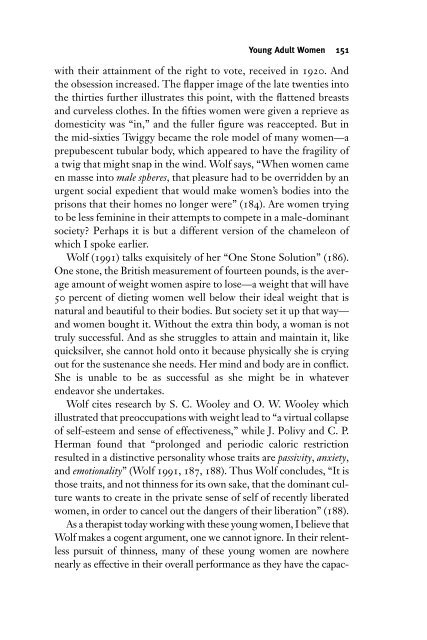Eating Disorders - fieldi
Eating Disorders - fieldi
Eating Disorders - fieldi
You also want an ePaper? Increase the reach of your titles
YUMPU automatically turns print PDFs into web optimized ePapers that Google loves.
Young Adult Women 151<br />
with their attainment of the right to vote, received in 1920. And<br />
the obsession increased. The flapper image of the late twenties into<br />
the thirties further illustrates this point, with the flattened breasts<br />
and curveless clothes. In the fifties women were given a reprieve as<br />
domesticity was “in,” and the fuller figure was reaccepted. But in<br />
the mid-sixties Twiggy became the role model of many women—a<br />
prepubescent tubular body, which appeared to have the fragility of<br />
a twig that might snap in the wind. Wolf says, “When women came<br />
en masse into male spheres, that pleasure had to be overridden by an<br />
urgent social expedient that would make women’s bodies into the<br />
prisons that their homes no longer were” (184). Are women trying<br />
to be less feminine in their attempts to compete in a male-dominant<br />
society? Perhaps it is but a different version of the chameleon of<br />
which I spoke earlier.<br />
Wolf (1991) talks exquisitely of her “One Stone Solution” (186).<br />
One stone, the British measurement of fourteen pounds, is the average<br />
amount of weight women aspire to lose—a weight that will have<br />
50 percent of dieting women well below their ideal weight that is<br />
natural and beautiful to their bodies. But society set it up that way—<br />
and women bought it. Without the extra thin body, a woman is not<br />
truly successful. And as she struggles to attain and maintain it, like<br />
quicksilver, she cannot hold onto it because physically she is crying<br />
out for the sustenance she needs. Her mind and body are in conflict.<br />
She is unable to be as successful as she might be in whatever<br />
endeavor she undertakes.<br />
Wolf cites research by S. C. Wooley and O. W. Wooley which<br />
illustrated that preoccupations with weight lead to “a virtual collapse<br />
of self-esteem and sense of effectiveness,” while J. Polivy and C. P.<br />
Herman found that “prolonged and periodic caloric restriction<br />
resulted in a distinctive personality whose traits are passivity, anxiety,<br />
and emotionality” (Wolf 1991, 187, 188). Thus Wolf concludes, “It is<br />
those traits, and not thinness for its own sake, that the dominant culture<br />
wants to create in the private sense of self of recently liberated<br />
women, in order to cancel out the dangers of their liberation” (188).<br />
As a therapist today working with these young women, I believe that<br />
Wolf makes a cogent argument, one we cannot ignore. In their relentless<br />
pursuit of thinness, many of these young women are nowhere<br />
nearly as effective in their overall performance as they have the capac-









